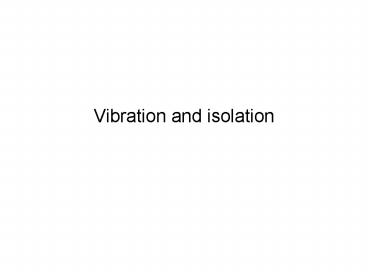Vibration and isolation - PowerPoint PPT Presentation
1 / 14
Title:
Vibration and isolation
Description:
Check out Prof. Burge's questions on mid-term review. Many concern material properties in this and last lab ... Tripod arrangement used for mounting early AFM's ... – PowerPoint PPT presentation
Number of Views:172
Avg rating:3.0/5.0
Title: Vibration and isolation
1
Vibration and isolation
2
Opportunity to review mid-term
- Check out Prof. Burges questions on mid-term
review - Many concern material properties in this and last
lab - Most materials from last lab still close at hand
- Other mechanical situations can be demonstrated
with items being used in Vibrations lab ask if
?s - Mentally review if you have questions about the
materials because they are easy to find now - If you think of other tests we might do on any of
these materials let us know
3
Seismic isolation
- Use very low spring constant (soft) springs
- Tripod arrangement used for mounting early AFMs
- Had long period (rigid body) vibration but
isolated above resonance - Large supported mass also lowers resonance
- Measure with accelerometers, one for each
direction
4
Optical table legs
- Same basic idea low spring constant support
- Table will tilt as a whole but not transmit floor
- (seismic) vibration
- Table will couple through electric wires, etc.
- Equipment on table sensitive to acoustic vib.
- Suspension becomes unstable if CG too high
- Must use three active legs and one slave
otherwise unstable
5
Coupled vibration
- Good and bad electric cables bad
- Coupling interferometer to mirror under test is
good - Both vibrate together (in phase) so fringes still
- Nice animation in references of coupled masses
- Gives idea of multiple modes in solids
- This is a one D model but can see effect in other
D - Simulate in lab with sample of different springs
and masses
6
Acoustic vibration
- Sound (acoustic vibration) is air pressure waves
- Transmitters (vibrating plates - speaker cones)
are also good receivers - Decrease coupling by putting holes in plates
- Making plates of damped materials (lead sheet)
- Acoustic coupling often not recognized for what
it is - Need a sound pressure sensor (microphone not
accelerometer)
7
Resonances and stiffness
- Cantilever wire (rod) off speaker cone
- Note fundamental and higher modes
- Note how sharp the resonance is, high Q
- Use resonance, length and diameter to find E
- Also, clamp wire as cantilever, add small weight
measure deflection and calculate E - Do two methods give about the same value for E
8
Torsional rigidity
- For solid of uniform circular cross-section, the
torsion relations are - T/J GF/l
- where
- F is the angle of twist in radians.
- T is the torque (Nm or ftlbf).
- l is the length of the object the torque is being
applied to or over. - G is the shear modulus or more commonly the
modulus of rigidity and is usually given in
gigapascals (GPa), lbf/in2 (psi), or lbf/ft2. - J is the torsion constant for the section .
- the product GJ is called the torsional rigidity.
- Applying small torque difficult so measure
frequency and find G
9
Kinematic stackups
- Problem illustrated by convex test plate
- Measure frequency of vibration (rocking)
- From geometry of part is this reasonable?
- Would frequency be higher or lower if longer
radius? - Nothing is flat so need to make flat to flat
connections kinematic - One thing that helps is acoustic damping thin
air film
10
Measurement Schema
- Measurement tools 10x more accurate (or
sensitive) than tolerance implies confidence in
measurement - In optics, measuring accuracy about same as
tolerance need error separation methods - Quantum optics act of measuring changes result
11
Symmetry and reversal
Assume f(x) over -1 to 1 To find fe(x) 1/2f(x)
f(-x) fo(x) 1/2f(x) f(-x) Works for
surfaces too fee ¼f(x,y) f(-x,y) f(x,-y)
f(-x,-y), etc
12
Centroid and remove rotationally symmetric error
Relative pseudo aberration value 9.51 9.38 1.
56
13
Pseudo astigmatism and coma
.75
1.02
.71
.57
14
(No Transcript)































